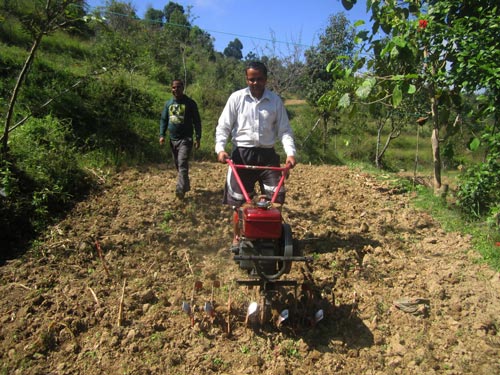
The recent 7.6 magnitude earthquake that struck Nepal on 25 April, followed by a 7.3 magnitude aftershock on 12 May and several hundred additional aftershocks to date, has had huge negative impacts on the country’s agriculture and food security. Around two-thirds of Nepal’s population relies on agriculture for their livelihood and agriculture contributes to 33 percent of Nepal’s GDP. It is estimated that about 8 million people have been affected by the earthquakes, with smallholders in hilly regions being most hard-hit.
The earthquake damaged or destroyed agricultural assets, undermining the longer-term food production capacity of farm families and disrupting critical input supply, trade and processing networks. Farmers lost grain and seed stocks, livestock, agricultural tools and other inputs, and are facing significant shortages of agricultural labour. Widespread damage to seed and grain storage facilities have affected smallholder farmers’ ability to secure their harvested crops through the rainy season.
In response to the devastation, USAID-Nepal has provided US$1 million for earthquake relief and recovery to the CIMMYT-led Cereal Systems Initiative for South Asia in Nepal (CSISA-NP). The Earthquake Recovery Support Program, for a period of 13 months, will be implemented in close coordination with the Ministry of Agricultural Development (MoAD), Department of Agriculture (DoA), Department of Livestock Services (DoLS), Nepal Agricultural Research Council (NARC) and District Disaster Relief Committee (DDRC). The districts that will receive support include Dolkha, Kavre, Khotang, Makwanpur, Nuwakot, Ramechap, Sindhupalchowk, and Solukhumbu, which have suffered particularly high levels of damage.
“Even if seed is available, the capacity for farmers to plant and harvest crops has been severely diminished due to the loss of draft animals and the exacerbation of labor shortages,” said Andrew McDonald, CIMMYT Principal Scientist and CSISA Project Leader. “We will reach more than 33,000 farming households through seed and grain storage facilities, mini-tillers and other farm machines, agricultural hand tools, technical training and agronomy support,” added McDonald.
The program will provide 50,000 grain storage bags, 30 cocoons for community grain storage, 400 mini-tillers and other modern agriculture power tools (e.g., reapers, maize shellers, seeders), 800 sets (5 items in a set) of small agricultural hand tools, and 20,000 posters on better-bet agronomic practices for rice and maize. “We will first focus on getting small horsepower mini-tillers into affected communities, and subsequently broadening the utility of these machines to power a host of essential agricultural activities including seeding, reaping, threshing and shelling, as well as powering small pumps for irrigation,” said Scott Justice, Agricultural Mechanization Specialist, CSISA-NP.
At the program’s inception workshop held recently on 28 August, Dr. Beth Dunford, Mission Director, USAID Nepal, remarked that USAID-Nepal has arranged a special fund to help earthquake-affected people. Beyond the devastation of houses, public infrastructure like roads, the earthquake has seriously disrupted the agriculture and rural economy throughout the impacted districts. Re-establishing vital agricultural markets and services in the aftermath of the earthquake is key to how quickly these communities will recover, underlined Dunford.
For effective coordination and monitoring of activities in the program, Central Level Management Committee, District Level Management Committee and Local Level Management Committee have already been formed. They aim to identify most earthquake affected areas within a district and will ensure efficient and transparent distribution of support items.
Dr. Adhikari, Joint Secretary, MoAD, highlighted that the Ministry feels a real sense of ownership over this program and is committed to implementing the activities through its network. He said the farm machinery support program will be a perfect platform for MoAD to expand its farm mechanization program into other areas of the country. The Earthquake Recovery Support Program also aligns with the Agriculture Development Strategies of the Government of Nepal, which focuses on community-wide inclusive development.
 Climate adaptation and mitigation
Climate adaptation and mitigation 
